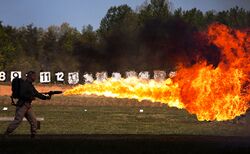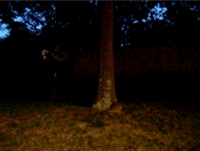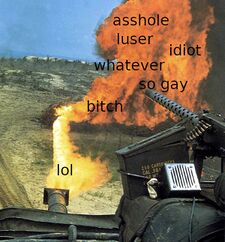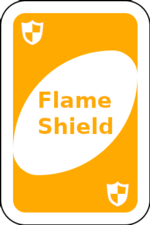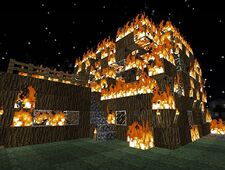Flamethrower
“Now that's a ring of fire!”
“The flamethrower proves that some time, somewhere, someone said to himself, 'You know, I want to set those people on fire, but I'm just not close enough to get the job done.'”
The flamethrower is a military weapon that revolutionized warfare. It consists of a typed insult, normally anonymous, that makes the soldier uninterested in fighting. It is faithful to the philosophy that Tzun Tzu — gesundheit! — laid down in The Art of War, namely, that a much less taxing endeavor than confronting an enemy and exterminating each and every one of them was sufficient heckling to get them to give you what you want with no confrontation at all.
History[edit]
Invention[edit]
Frightening movies about World War 2 showed the Third Reich using shoulder-fired weapons to char-broil and fricassee Jews, gays (then called homosexuals), and itinerant noisy yard-sale operators (then called gypsies).
In reality, the flamethrower was used first by the Allies. General George S. Patton was the earliest adopter of the flamethrower. Unfortunately, he mostly used it on his own troops, such as a certain "cowardly pussy" of an enlisted man who refused to charge a German machine-gun emplacement when ordered to. This was the first recorded "flame," or perhaps it was the accompanying bitch-slap in the soldier's bed in the psychiatric ward. Patton's use of the flamethrower unfortunately attracted friendly fire on the part of his civilian commanders, which removed him from the "theater" until the whole story was told in the motion-picture theater.
Nevertheless, the flamethrower caught on in warfare in generally tight areas. It was particularly effective in France, as flamethrowers describing the French as "surrender monkeys" proved to be self-fulfilling and not just hurtful microagressions. France's return flamethrower fire at Germany (chiefly, yelling "That wasn't nice!") was easily repelled and the outcome was the stuff of history, until the Americans arrived with more clever flames.
Early warfare use[edit]
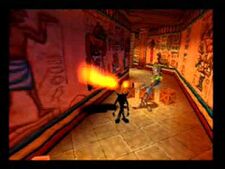
Military ordnance experts immediately tried to re-envision the flamethrower as an incendiary device. However, as a military weapon, it sucked. The original design was nothing more than a backpack-sized plastic gasoline can with a nozzle at the bottom. Because of its cheap casing, it was easy to puncture. Bullets easily penetrated the pack and set it on fire, in seconds resulting in discomfort for the operator. The enemy also discovered that puncturing the tank resulted in a trail of gasoline leading back to the hideout like a long fuse (a theme repeated in post-war movies). The early flamethrower was more of a danger to the burner than the burnee. This was well-known and the early flamethrower operators were usually firebugs to begin with.
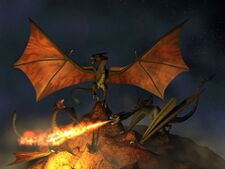
Improvements included a stronger, molded metallic casing replacing the flimsy plastic, plus spring-loading so the trigger could no longer lock in place. However, the design was still inherently flawed: you were a walking time bomb, ready to go off at any second. More armor was an ungainly option, as well as a costly one for a single doomed private. However, a breakthrough in tank design allowed enough room for more than one flamethrower to be mounted for assault.
The ungainly incendiary flamethrower was finally abandoned as a military weapon. The last straw was its tendency to burn down everything in the military theater, including members of minority groups, cross-dressers, and vegans whom the American "Army of One" is so desperate to recruit. The armed forces have now gone full-circle to the original flamethrower, that ruthless dispenser of traumatizing insults.
Combat[edit]
Tactics[edit]
A flamethrower squad consists of the standard set of men: one young, strong-willed leader; the slightly envious second in command; three expendable flame thrower supports; the wisecracking ammo lugger; and a nervous pessimistic spotter. The standard procedure is to have two supporting flamers flank left, the rest of the supporters and the leader at the front, the ammo supplier hanging not too far off and the spotter hiding behind the ammo supplier. Of course, the standard assault procedures do not apply for every situation (especially ones involving tanks), and since the rest of the tactics book is important only for the squad leader to read, let's leave him to it.
Operation[edit]
The flamethrower tank accepts and stores at least 500 possible insults over a span of six different languages, variations and combinations regularly accepted through the mic, and the effectiveness is most dependent on the ammo supplier, and not the receiver of the insults. Americans (especially ones in large urban areas) are the best suited for using the flamethrower. For example, the American insults are short, quick and can come with a steady stream of helpful profanity as well. Insults from Germany are a hit-or-miss endeavor, since the rough, harsh language can boost the life of a single ammo pack, but can also be defective at moments, due to the poor grammar.
A regular issue occurs when the flamethrower wielder runs out of breath and can have trouble forming insults and phrases on the battlefield. The solution to the problem was handled by having tag-along people help supply insults when the operator is unable to and must catch his breath for the short period of time.
Additionally, voice recording technology lets insults be stored and later used as ammunition for a flamethrower if in ammo-restricted conditions. This is not a new idea, since before the availability of handy voice recorders, parrots were brought out onto the battlefield and used to make a quick refill for the rare last-man-alive situations. Parrots were unreliable, and would often ask for crackers when they should be helping out the desperate soldier.
Countermeasures[edit]
“Sticks and stones can break your bones, but...”
When there is a flamethrower in the vicinity, defenders need a flame shield. The first flame shield was simply a wad of cotton (pulled apart and one piece pinched into each ear). This was an effective buffer for a single-flame squadron (for about eight minutes) but its lasting value was lacking, especially when up against a whole squad or an array of flamethrowers.
The most advanced modern countermeasure is called the "snappy retard." With one of these, the flamethrower victim can reflect the flame onto the assailant, effectively removing him from combat. The following snappy retards have been proven most effective:
- "Did not!"
- "See you, wouldn't wanna be you!"
- "Whenever you point at someone, three fingers are pointing back at yourself!"
Snappy retards are drilled into youngsters on a daily basis at all grade-school playgrounds. However, a drawback with the snappy retard is that it is solely available for defensive use, ineffective until the enemy fires first.
Modern flamethrowing[edit]
In teh Internet Wars[edit]
The Internet is a new battleground, but it is no less hectic. Trolls are able to start a flame war conventional shields cannot cover.
A good metaphor is Minecraft: you've built the most lovely house, including dyed carpet, potted plants, a trophy wall, and a map room. No matter how good your house is, no matter how nice you are in multiplayer mode — griefers will literally try to flame your house to the ground. But this one is easy — just don't build your house out of wood.
A general strategy is to calmly discuss the misunderstanding. Give peace a chance. See if they will see the light of reason.
Then, when that doesn't work, fight fire with fire and start an even bigger flame. You may not be safe, but hey — at least they'll be aflame too, the concept behind Mutual Assured Destruction that has kept the world's largest countries mostly safe from actual destruction for the better part of a century.
Recent developments[edit]
The recent increase in bandwidth to carry full-length movies has somehow enabled flamethrowers to deliver ever shorter bursts. A modern flame can consist of only four characters, such as STFU and GTFO.
Unicode has expanded the Internet character set to include Emoji suitable for the flamethrower 🔥, such as the swastika, the bomb 💣, the clown face 🤡, and the venerable poop Emoji 💩. With the greater bandwidth, these graphics can be repeated to augment their lethality to even adversaries on a per-megabyte plan. Graphics are available in every skin color, for personal targeting with a whiff of racism. As Unicode advances toward eight-byte characters, there will soon be enough characters for an unflattering caricature of every individual on Earth. When this is released, flamethrowers will be able to deliver a stinging personalized insult using only two characters.
